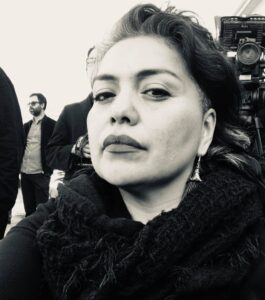“Ay que bonito es volar
A las dos de la mañana
A las dos de la mañana
Ay que bonito es volar
Ay mamá”.
—“La Bruja”
It was November—in the time of memories and dreams. She wore her long black hair down over her shoulders and her favorite white gown touched her calves. Her bare feet were dry like the desert dust, craving for a drop of water. Under the cherimoya tree, she sat on a concrete bench while she took in her surroundings that looked like her home and then continued on her journey. She saw the rabbit on the moon peer through the tall almond tree heavy with flowers; its leaves glistened and danced feverishly as she passed by. Even though the smell of eucalyptus trees permeated the backyard, she couldn’t smell it as much as she tried. Something else called her—a smell more powerful—the smell of bright orange cempazuchitl flowers.
As she got closer to the backside of the house, she recognized the geranium clay pots lining alongside the house. The estafiate and ruda plants were well taken care of—for a second, she thought they were hers. But as she approached a bedroom window, she saw her face reflected. She didn’t know if she was la Llorona or a bruja or the two of them in one. Through her eyes, she didn’t look terrifying—not to herself. Looking at her face did startle her a bit, but what startled her most were her feet. They weren’t touching the ground. Her body moved slowly, heavy with time on her shoulders, to her altar, where she found her picture in a wooden frame, the only picture of her, the one with her hair tight in a long braid. The candle’s flame flickered and the red, bright pink, royal blue, green, and yellow ribbon hanging from the window’s frame swayed as she moved to a corner in the living room next to la Virgen de Guadalupe. Her favorite dish—mole rojo, frijoles, and arroz—was still warm with her daughter and granddaughters’ hands. Next to the mole, her family had placed a glass of water to quench her thirst. She remembered who she was—she was Aurora. And her granddaughters, Paloma and Sofía, had guided her to the place of the living.
After reuniting with family members placed next to her on the family altar, Aurora then visited Helena, sleeping next to her husband. She found her in the same position she slept as a child. Staring at her daughter’s grown woman’s face, Aurora leaned over and kissed her daughter on the forehead. Helena woke up, stayed still and asked, “¿Mamá, eres tú?” With no answer and heavy with sleep, she went back to dreaming.
In the morning, I woke up confident my grandmother had visited the altar both Paloma and I had set up for her the night before. I sat on my bed recollecting my dream then rose to my feet and stared out the window. I had dreamt I was walking. No, I was floating like la Llorona but wasn’t sure if the woman in my dream was my grandmother—Aurora, a bruja, or la Llorona.
It was November—in the time of . . . “Ay de mí, Llorona Llorona, Llorona, llévame al río. Tápame con tu rebozo, Llorona, porque me muero de frío.”

Sonia Gutiérrez is the author of Spider Woman / La Mujer Araña (Olmeca Press, 2013) and the co-editor for The Writer’s Response (Cengage Learning, 2016). She teaches critical thinking and writing, women’s, gender, and sexuality studies, and multicultural studies. FlowerSong Press in McAllen, Texas, recently published her novel, Dreaming with Mariposas, winner of the Tomás Rivera Book Award 2021. Her bilingual poetry collection, Paper Birds / Pájaros de papel, is forthcoming in 2022. Presently, she is returning to her manuscript, Sana Sana Colita de Rana, working on her first picture book, The Adventures of a Burrito Flying Saucer, moderating Facebook’s Poets Responding, and teaching in cyberland. “Dreaming with Aurora” appears in Dreaming with Mariposas.





















































